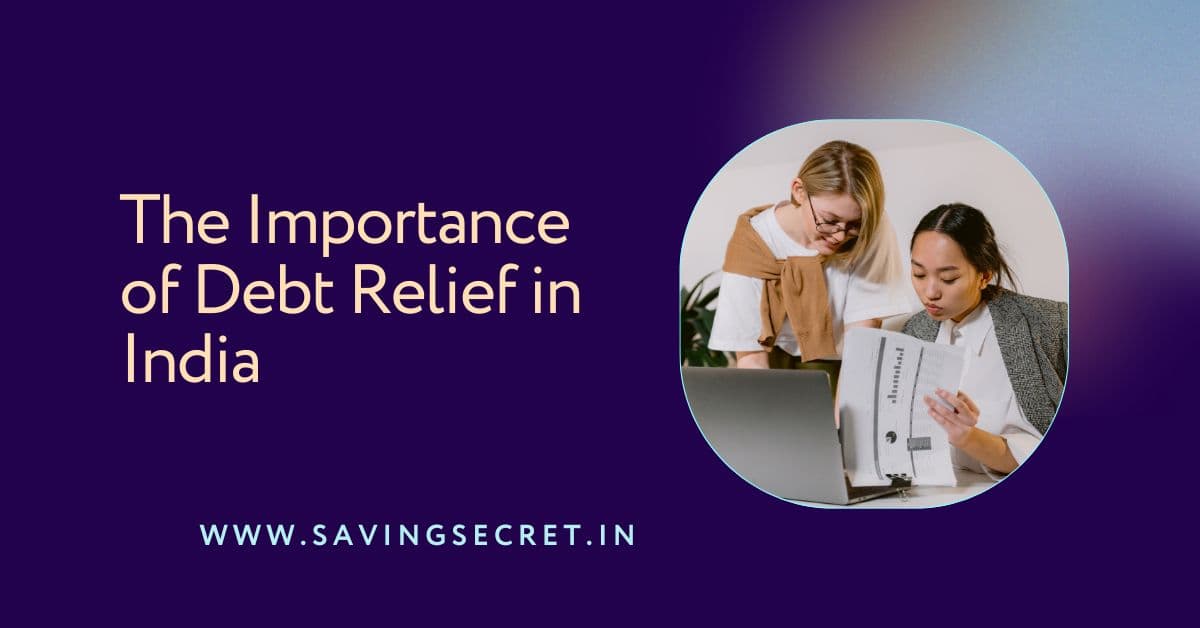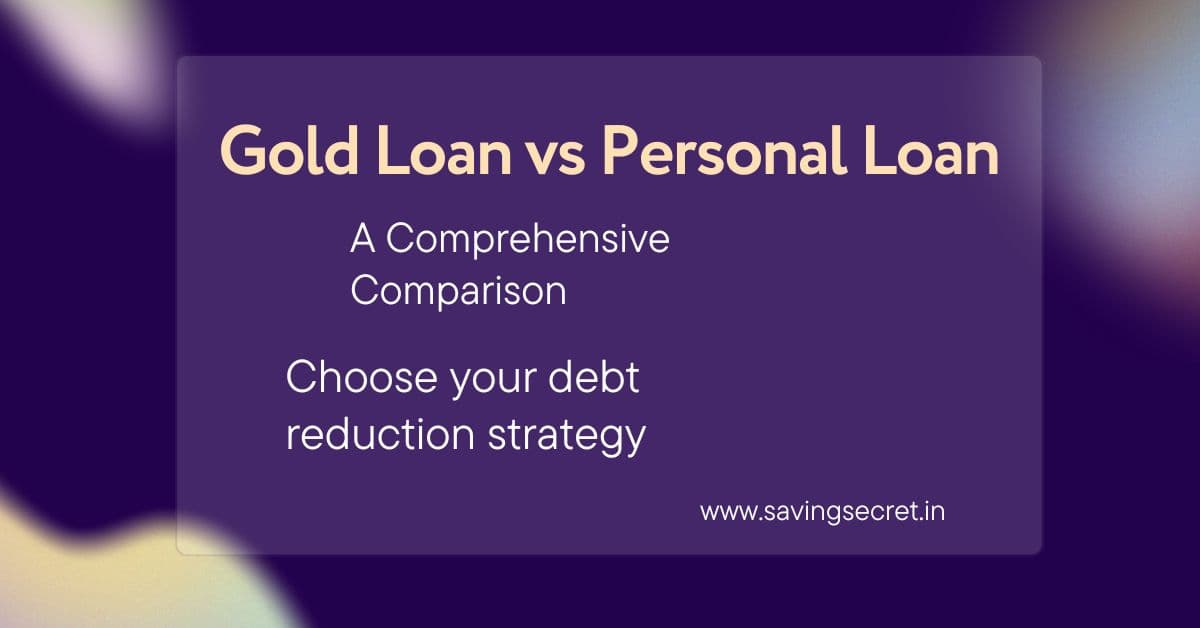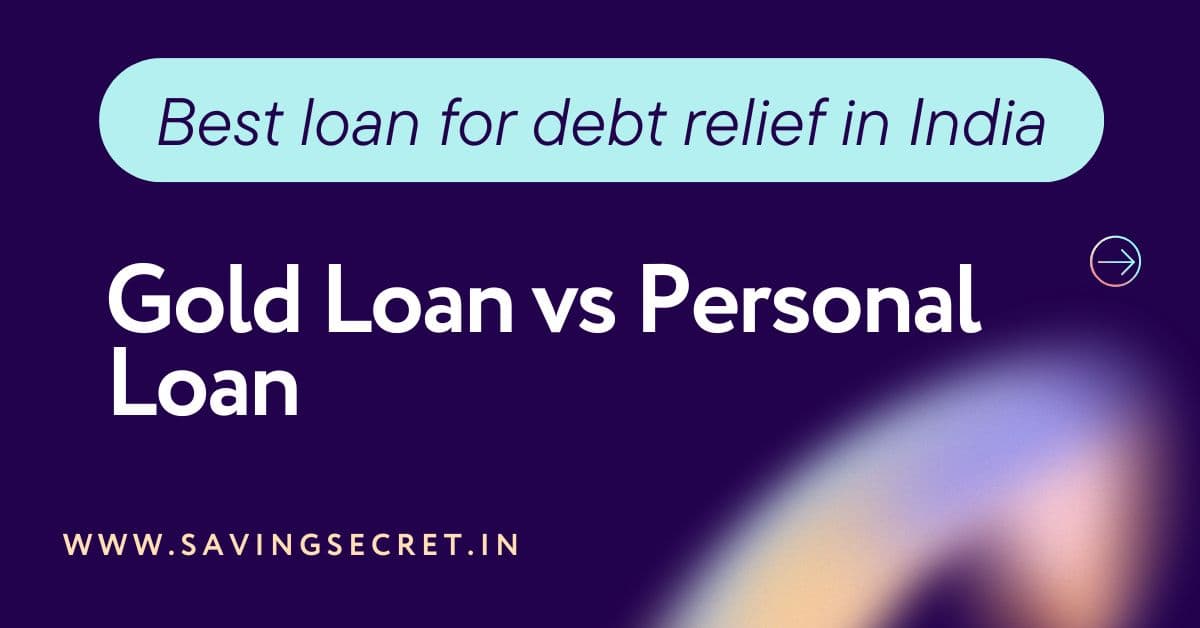Gold Loan vs Personal Loan: Financial crises, such as paying off high-interest credit card debt, wedding costs, or medical expenditures, sometimes force families in India to look for loans. According to RBI projections, loans represent a lifeline for many, with over 100 million retail borrowers and ₹90 lakh billion in outstanding credit as of 2025. Two well-liked choices are personal loans, which are flexible and unsecured, and gold loans, which are secured by your jewellery. But which one provides more relief when you’re drowning in debt? Should you take out a fast personal loan from a Delhi NBFC or a Mumbai bank, or should you pledge your grandmother’s gold bangles?
We’ll go over interest rates, eligibility, payback, and other topics specific to situations like paying off a ₹5 lakh emergency in Kolkata or consolidating a ₹2 lakh debt in Bangalore. With India’s digital economy growing—UPI transactions reached 14.4 billion in February 2025—and inflation at 5–6%, picking the appropriate loan might save you hundreds of dollars. Beginning today, let’s begin the last battle between personal loans and gold loans!
The Importance of Debt Relief in India
With credit card balances at 36% interest, unofficial loans at 20%, or many EMIs eating up half of your ₹50,000 monthly, debt may mount quickly. Regaining financial independence to save for a home, children’s education, or retirement is more important to Indian families than just paying off debt. Personal loans and gold loans are popular options because:

- Fast Access: Money in days (personal) or hours (gold).
- Consolidating Debt: Repay expensive debts (₹1 lakh at 36% versus 12%).
- Flexibility: Use for any need, including EMI relief, weddings, and medical.
- Affordability: Cheaper than moneylenders or credit cards.
- Credit Boost: Repayment on time raises CIBIL (700+ for better loans), which boosts credit.
However, there are trade-offs associated with each loan; personal loans need higher interest rates, while gold loans put your jewellery at danger. To identify the greatest debt relief solution, let’s dissect the differences.
Gold Loan vs Personal Loan: A Comprehensive Comparison
Let’s analyse important aspects, such as interest rates, eligibility, tenure, and more, with advice for Indian borrowers to choose which loan best fits debt relief in India.

1. First, what are personal loans and gold loans?
Gold Loan:
- A secured loan secured by 22K or 24K worth of gold jewellery, such as chains and bangles.
- Lenders include jewellers, NBFCs (Muthoot, Manappuram), and banks (SBI, HDFC).
- Use: Business requirements, crises, and debt payback.
- Example: For a loan of ₹3 lakh, pledge 100g of gold.
Personal Loan:
- Based on credit and income, this type of loan is unsecured and requires no security.
- Lenders include NBFCs (Bajaj Finance, Tata Capital) and banks (ICICI, Axis).
- Use: Adaptable—weddings, trips, debt forgiveness.
- An illustration would be a ₹3 lakh loan for a ₹50,000 wage person.
2. Rates of Interest
Gold loans: 8–14% annually
- Why Lower? Less risk for lenders when gold is used as security.
- For instance, ₹3 lakh at 10% interest is ₹30,000 annually.
- Hacks: Examine the differences between banks (SBI, 11%) and NBFCs (Muthoot, 9%).
Personal loans: 10% to 24% annually
- Why Is It Higher? Dependent on CIBIL, unsecure (750+ receives 10-12%).
- For instance, ₹3 lakh at 15% interest equals ₹45,000 annually.
- Hacks: With good credit, refinance at 12% to save ₹9,000 annually.
Debt Relief Winner: Reduced rates for gold loans Spend ₹3 lakh and save ₹10,000 to ₹20,000.
3. Eligibility and Records
- Simple: Own gold (10g minimum), be between the ages of 18 and 70.
- Documents: evidence of address, Aadhaar, and PAN; no evidence of income.
- Why Is It Easy? In 30 minutes, get a ₹2 lakh loan with gold as security.
- For instance, Anita promised 50g of gold without a pay stub.
Personal Loan
- Requirements: CIBIL 700+, ₹15,000+ income, age 21–60.
- Documents: ITR, bank statements, pay stubs, Aadhaar, and PAN.
- What Makes It Tough? Banks examine repayment capacity, which is riskier.
- For instance, Ravi received ₹2 lakh from his ₹25,000 income plus 750 CIBIL.
The gold loan won for debt relief since it is quicker and has less requirements for urgent needs.
4. The loan amount
Gold Loan: ₹10,000 to ₹50 lakh, depending on the 2025 gold price of ₹4,000 to ₹5,000/g.
- 70–80% of the market value of gold (₹3 lakh for 75g at ₹4,000/g) is the limit.
- Why? protects lenders in the event of a 10% decline in gold prices.
- For instance, Sunita received ₹2 lakh for 50g, which satisfied her credit card debt.
Personal Loan: Depending on income (3-5 times monthly earnings), personal loans range from ₹50,000 to ₹25 lakh.
- Limit: CIBIL 700+, ₹2 lakh for a salary of ₹40,000.
- Why? makes sure the ₹5,000 EMI and the ₹40,000 income match.
- For instance, Priya received a ₹3 lakh loan for her ₹50,000 salary.
Winner for Debt Relief: Personal for bigger loans (₹5–10 lakh), gold for smaller ones (₹1–5 lakh).
5. The Tenure
Gold loans: Gold loans are typically bullet-repaid (principal at the end, interest monthly) and last for three months to three years.
- Why so brief? Gold volatility: ₹3,800 tomorrow against ₹4,000/g now.
- Hacks: Pay interest each month (₹2,000) and renew the loan (₹2 lakh extended for one year).
- For instance, Anil cleared ₹2 lakh in two years by paying ₹2,000 per month in interest.
Personal Loan: fixed EMIs (principal plus interest) for 1–5 years.
- Why Was It Longer? The cost of the spreads is ₹3 lakh at 12%, or ₹6,600 per month for five years.
- Hacks: Reduce tenure and save ₹30,000 in interest by prepaying (plus ₹50,000).
- For instance, Sunita paid off her ₹5,000 EMI in four years, clearing ₹2 lakh.
The personal loan won for debt relief since its longer term makes cash flow easier.
6. Time Spent Processing
Gold Loan: two hours to thirty minutes.
- Why Quick? KYC plus gold appraisal (₹4,000/g) equals immediate money.
- For instance, Priya received ₹1 lakh for a hospital bill in just one hour.
Personal Loan: one to seven days.
- Why Was It Slower? Income, CIBIL checks—NBFCs 1-2, banks 2-3 days.
- For instance, Anil had to wait three days for clearance of ₹2 lakh.
Gold Loan was the winner for debt relief; it immediately addressed urgent debt demands.
7. Flexibility in Repayment
Gold Loan:
- Adjustable: Pay the principle at any time and the interest each month (₹2,000).
- Risk: Default results in a gold auction (a loan of ₹3 lakh loses 75g).
- Tricks: Interest is decreased with a partial repayment of ₹50,000.
Personal Loan:
- Resolved: EMI is required (₹6,600); non-payment lowers CIBIL by 20 points.
- Hacks: SBI and HDFC provide penalty-free prepayment of ₹1 lakh, which saves ₹20,000 in interest.
Debt Relief Winner: Pay-as-you-can gold loans accommodate erratic income.
8. Asset Loss Risk
Gold Loan: High—gold (family heirlooms lost) is at danger of default.
- Why? After three late payments, the lender auctions—₹3 lakh loses 75g.
- Hacks: It’s safer to borrow 50% of the gold value (₹1.5 lakh as opposed to ₹3 lakh).
- For instance: Anita suffered grief after losing 20g for ₹80,000 default.
Personal Loan: No collateral is required for a personal loan, however the CIBIL falls from 700 to 650.
- Why? Legal action may be taken—a default of ₹2 lakh results in a court notice.
- Hacks: Create a ₹30,000 emergency fund to pay three EMIs.
- Example: No assets were lost when Ravi’s missed EMI struck CIBIL.
No heirloom risk—personal loan—winner for debt relief.
9. Effect on Credit Rating
Gold Loan: Minimal; regular payments improve score (from 700 to 720) when reported to CIBIL.
- Why? Secured loan: little investigation until there is a default.
- For instance, Sunita’s loan of ₹2 lakh increased CIBIL by 30 points.
Personal Loan: High—EMI delays result in a 20–50 point monthly score decrease.
- Why? Unsecured—banks keep a tight eye on it.
- As an illustration, Priya’s late EMI reduced CIBIL from 750 to 700.
Debt Relief Winner: If paid back, a gold loan reduces credit risk.
10. Use of Debt Consolidation
Gold Loan: For minor, expensive debt (₹1-3 lakh, 36% credit card), a gold loan is the best option.
- Why? A 10% rate saves ₹26,000 year compared to a 36% rate.
- Hacks: Pay interest each month (₹833) and clear your cards.
- For instance, Anil saved ₹50,000 by consolidating his ₹2 lakh credit card debt.
Personal Loan: For several loans (₹3-10 lakh, 15-20%), personal loans are the best option.
- Why? 5-year EMI plus 12% rate—₹5 lakh = ₹13,200/month.
- Tricks: Save ₹30,000 by balancing transfers from 15% to 12%.
- For instance, Sunita combined ₹5 lakh debts, saving ₹1 lakh in interest.
Debt Relief Winner: Tie—personal for big, gold for small.
Which is best for debt relief in India?
The cost and flexibility of a gold loan vs a personal loan might significantly differ when it comes to debt relief in India. Compared to personal loans, which often have interest rates between 10% and 24%, gold loans typically have lower rates, ranging from 8% to 14%. Gold loans are more accessible in terms of eligibility because they don’t demand evidence of income or a good CIBIL score, which makes them perfect for people with bad credit or inconsistent income. Conversely, personal loans have more stringent requirements for qualifying and rely significantly on your credit history.

Personal loans typically range between ₹50,000 and ₹25 lakh, depending on income, whereas gold loans can range from ₹10,000 to ₹50 lakh, depending on the value of the gold. Although personal loans can have a longer term (up to five years), gold loans are processed more quickly and are frequently disbursed in 30 to 2 hours as opposed to 1 to 7 days for personal loans. While personal loans have set EMIs, gold loans enable interest-only payments with a lump-sum principle, giving borrowers additional repayment flexibility. However, although personal loans are unsecured, gold loans represent a larger asset risk because your gold may be put up for auction in the event of failure.
Finally, gold loans are a safer choice for people trying to prevent credit harm because they have little effect on your credit score. All things considered, a gold loan is frequently the superior option in India for quick, flexible, and less expensive debt relief—especially if you have gold assets and a low credit score.
When to Get a Gold Loan:
Ideal For: For immediate, minor debt relief (between ₹50,000 and ₹3 lakh).
Various situations:
- At 36%—10%, you can pay off ₹1 lakh in credit card debt and save ₹26,000 year.
- ₹2 lakh for an urgent medical need—no evidence of income, quick money.
- irregular income—make monthly interest payments of ₹2,000, with principle paid later.
Why: Fast access, adjustable payback terms, and reduced rates (8–12%).
Gold loss risk: borrow half of the amount (₹1 lakh vs. ₹2 lakh).
Selecting a Personal Loan at the Right Time
Ideal For: Consolidating large debts (₹3–10 lakh).
Situations:
- Convert 15–20% of ₹5 lakh loans into 12%–13,200 EMIs over 5 years.
- Wedding costs ₹3 lakh; extended tenancy makes financial flow easier.
- 12% rate, high CIBIL (750+), and no asset risk.
Why: Predictable EMIs, longer tenure, and no collateral.
Risk: CIBIL decline; create an EMI buffer of ₹30,000.
Debt Relief Verdict
Gold Loan Wins: For short, minor debt relief (₹1-3 lakh), Gold Loan Wins offers reduced rates, no proof of income, and speedy funding. Perfect for emergencies, credit card debt, and irregular incomes.
Personal Loan Wins: For significant, long-term debt consolidation (₹3–10 lakh), this loan option is ideal for salaried individuals with good CIBIL since it has a longer tenure and no asset risk.
Tips: A comparison of ₹2 lakh at 10% (gold) and 12% (personal) shows that gold saves ₹4,000 year.
Examples from Real Life
Relief from Anil’s Credit Card
Anil, a Delhi resident aged 30 who makes ₹40,000 per month:
- Credit card debt: ₹1.5 lakh (36%).
- 40g for ₹1.6 lakh at 10% is the gold loan amount.
- Saved: ₹40,000 annually compared to 36%—paid off in two years.
- He claims, “Gold saved my finances.”
Priya’s Consolidation of Loans
Mumbai resident Priya, 35, makes ₹60,000 a month:
- ₹5 lakh in debt (15% personal and 20% card).
- Personal Loan: ₹13,200 EMI, ₹5 lakh at 12%.
- Interest saved: ₹1 lakh over a five-year period.
- “No gold was at risk,” she says.
The Medical Emergency of Sunita
Sunita, a 45-year-old unemployed person from Kolkata:
A medical bill of ₹2 lakh is the debt.
- 50g for ₹2 lakh at 9% is the gold loan amount.
- Interest paid: ₹1,500 per month; paid off in 18 months.
- “We were saved by quick funds,” she says.
Smart Tips for Debt Relief in India
- Compare Rates: Save ₹6,000 annually by using PaisaBazaar, which offers ₹2 lakh at 9% (gold) instead of 12% (personal).
- Emergency fund: Save ₹20,000 for an emergency fund, which will pay three EMIs or gold interest.
- PrePay: Pay it back early to save ₹30,000 in interest on a ₹3 lakh loan with a ₹50,000 incentive.
- CIBIL Boost: 750+ receives 10-12% personal loans if EMIs are paid on time.
- Gold Safety: Steer clear of auctions by borrowing 50% of the amount (₹1 lakh vs. ₹2 lakh).
- Digital tools: include ClearTax (debt tracking) and PhonePe (payments).
- Learn: For loan advice, see YouTube (e.g., CA Rachana Ranade).
Typical Problems and Their Solutions
- Problem: Fear of losing gold is the challenge.
Solution: Pay back each month after borrowing less (₹1 lakh as opposed to ₹2 lakh). - Problem: High personal borrowing rates (18%) provide a challenge.
Solution: Refinance at 12% and raise your CIBIL to 750+ to save 12,000 year. - Problem: Short gold loan duration is a challenge.
Solution: Pay ₹2,000 in interest each month and renew (₹2 lakh for a year). - Problem: No evidence of income.
Solution: Select a gold loan; no pay stubs are required. - Problem: Having several debts might be confusing.
Solution: Consolidate—a personal loan of ₹5 lakh at 12% instead of 20%.
Why This Decision Is Important in India
India has a huge loan market at ₹90 lakh crore (2025), with personal loans costing ₹10 lakh crore and gold loans costing ₹5 lakh crore. Making sensible choices saves:
- Money: interest of ₹10,000 to ₹1 lakh.
- Credit: 750+ CIBIL for upcoming loans.
- Peace: Family stability comes from debt reduction.
- Digital Edge: Loans can be compared in five minutes using apps like BankBazaar.
Resources and Tools
- Apps: ClearTax (tracking), PhonePe (payments), and Paisabazaar (rates).
- Websites: Moneycontrol (advice) and RBI (lender information).
- Freebies include YouTube lessons and SBI EMI calculators.
- Communities: For loan guidance, see r/IndiaInvestments.
Make Your Choice Today
Choose your debt reduction strategy right away:
- Prior to April 15, 2025, compare loans.
- Apply by April 25, 2025, for a loan of ₹1 lakh.
- By April 30, 2026, pay off ₹50,000 in debt.
You can get out of debt with either gold or personal. To help friends or relatives who are struggling with debt, share this advice with them. Every Indian may overcome debt if they make the correct decision!
Loan Repayment Made Easy: Your Money Map
Refinancing Hacks for Low CIBIL Scores: Unlock Better Loans Terms
How to Use CRED for Credit Card Debt Management in India

